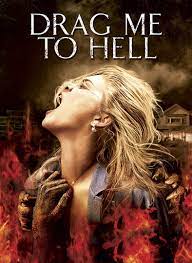Drag Me To Hell from a Psychoanalytical Perspective
Have you ever watched a horror film again that had a lasting psychological impact on you as a child? The kind of movie that made you spend weeks looking under your bed, sleeping with the lights on, and peering through your fingers? Even if you may believe that your childhood anxieties have passed, there may be a certain movie that even as an adult makes you shudder and makes you reluctant to view it alone. Well for me, that movie is Drag Me To Hell, directed by Sam Raimi.
 |
| Movie Poster: Drag Me To Hell (2009) |
Here's a quick synopsis of the film if you haven't watched it: The 2009 supernatural horror picture "Drag Me to Hell," helmed by Sam Raimi, tells a story of desperation, curses, and the blurry boundary between life and death. At the bank where she works, Christine Brown (played by Alison Lohman) gets involved in a terrifying struggle after turning down an elderly woman's request for a loan extension. Christine embarks on a terrifying adventure after a wicked curse is unleashed, trying to get away from a relentless demonic power.
The story starts with Christine walking past a bakery and looking at the cakes and pastries.
Despite looking at the cakes, she did not enter the shop and decided to continue go on her way to work at the bank. At the bank, she was seen drinking black coffee on her desk and her client is this old lady, named Sylvia Ganush. Ganush had asked for a third extension for her mortgage but Christine could not offer her that. Security guards were seen taking Sylvia Ganush away when she pleaded and cried in the bank while also attacking Christine saying that she was humiliated.
The movie continues with Alison deciding to go to Sylvia Ganush's house to apologise to the old lady, only for her to discover that Ganush had recently passed way and the funeral was held at Ganush's home. After making a scene at Ganush's house, family members of Ganush told Christine that she'll get what she deserved.
Christine started getting disturbed by some entities and it was only found out that Ganush had cursed her and within three days, a demon called Lamia would drag Christine to hell.
As I watched this movie again as an adult, it was only then I had realised that a lot of the scenes with 'ghosts' in it revolves around food and vomiting (as per pictures).
This is just one of the theories from the film. The theory is that Christine is actually suffering from an eating disorder (ED). The ghosts only appears into scene when she is around food. The scene where she's having dinner with her boyfriend's parents, the scene at the funeral and many more. At the start of the film, when the film was focusing on the mug of coffee before focusing on Christine and Sylvia Ganush, it is said to be that Christine was actually just hallucinating the 'dirty nails' of Sylvia Ganush due to lack of food/energy.
If we were to adopt this theory, it would go inline with Repression and the Unconscious from the Psychoanalytical Theory. Sigmund Freud's psychoanalytic theory places a strong emphasis on how the unconscious mind and repression shape human experience and behaviour.
UNCONSCIOUS MIND
Freud proposed the division of the mind into three categories: preconscious, unconscious, and conscious. Thoughts, memories, and desires that are not consciously aware at the moment but nevertheless impact behaviour are stored in the unconscious mind.
REPRESSION
Pushing ideas, memories, or desires into the unconscious in order to keep them from creating distress is known as repression, an unconscious defence mechanism. It serves as a means of shielding the person from ideas or feelings that are too dangerous.
Thus, there are evidences from the film that show's Christine suffering from a type of eating disorder and is actually trying to avoid food and vomit when she associated it with having bad things happening to her whenever around food.
"Drag Me To Hell" is a must-see for anyone who enjoys a good scare and a decent dose of sardonic humour. Its flawless fusion of humorous ridiculousness and terrifying sequences distinguishes it from other horror films. Thus, grab your popcorn, buckle in for some spine-tingling moments, and allow "Drag Me To Hell" to whisk you away on an incredibly entertaining and pleasant journey. Who said being afraid couldn't also be a daring and thrilling experience? Just don't forget to look under your bed before turning out the lights!
I am Nurin Afiqah (2015414), and this is my review on the film Drag Me To Hell from a Psychoanalytical Theory.
Till next time!
.jpg)
.jpg)

.jpg)


Comments
Post a Comment